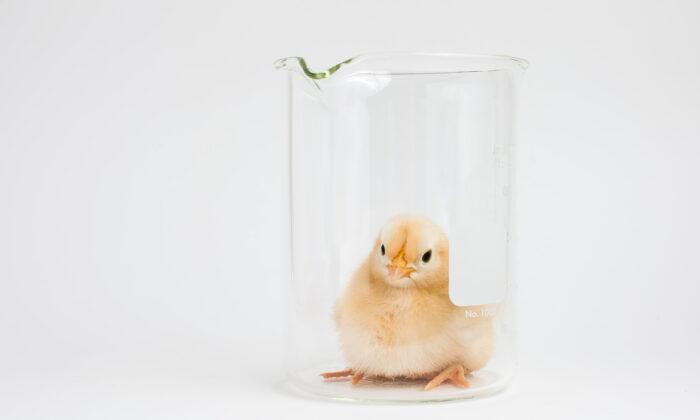STORY AT-A-GLANCE
- Each year, more than 6 billion male chicks are killed worldwide, up to 300 million of them in the U.S., as part of the industrialized egg industry
- A team of Israeli scientists have filed a concept patent that involves genetically engineering hens to pass on a lethality, or killer, gene to male embryos, which would eliminate them before they hatch
- Once the eggs are laid, blue light would then be used to activate the lethality gene and kill all of the male embryos in-ovo, or in the egg
- This will likely be presented as a more “humane” approach, but it comes with significant risks, including to the hen, because the lethality gene is likely to produce highly toxic protein that could make the hen sick
- The European Commission stated that such GE hens and their eggs would not be classified as genetically modified organisms (GMOs) and therefore would exist outside of the EU’s GMO regulations
Because males cannot produce eggs, and don’t grow enough meat to make them useful for human consumption (as opposed to broiler chickens, bred to grow unnaturally large), they would cost more to raise than they would be “worth.” With complete disregard for life, egg producers therefore “cull” the males, or kill them off, shortly after birth, sending them to be used as pet feed, livestock feed or simply filler for landfills.
GE Hens Pass on Lethal Gene to Male Embryos
The patent, which was filed with the State of Israel Ministry of Agriculture & Rural Development listed as the applicant, and Yuval Cinnamon and Enbal Ben-Tal Cohen as the inventors,3 uses the gene-editing tool CRISPR, or Clustered Regularly Interspaced Short Palindromic Repeat, to insert a foreign gene — the lethality gene — into the male sex Z chromosome.4The genetically engineered (GE) hen would pass the lethality gene — which is supposed to only be activated by blue light — onto all male embryos. Once the eggs are laid, blue light would then be used to activate the lethality gene and kill all of the male embryos in-ovo, or in the egg.
“In order to ensure reliable killing of the male chick embryos at an early stage of their development, the lethality gene that the developers insert will have to be highly toxic.
The various lethality-inducing proteins mentioned in the patent that are supposed to work by inhibiting growth/development (paragraphs 0156, 0157) or essential signalling pathways, such as “bone morphogenetic protein antagonist” or “RNA-guided DNA endonuclease enzyme” (paragraphs 0159, 0160), may be too uncertain in their effects.
Therefore the developer will almost certainly choose to use a known highly toxic element — such as genes encoding for diphtheria toxin or ricin toxin, both of which are specifically mentioned in paragraph 0158 as possible candidates for the lethal gene.
The fact that the authors illustrate their concept using a diphtheria toxin lethality gene, albeit within the context of in vitro tissue culture cell experiments (Figure 24A), supports this line of thinking.”Further, the patent does not restrict the lethal gene to the types named, which means the scientists could use virtually anything, such as a gene encoding cholera toxin.
The Lethality Gene May Be ‘Leaky’
Aside from the problems inherent with introducing a lethal gene into a living species is the topic of its blue light activation. The lethal gene is supposed to remain dormant until blue light exposure, but there’s a chance it could still exert some level of toxicity even while in this inactive state. This “leaky” lethal gene could have implications for animal welfare and could pose a risk to the mother hens.“This raises the question of how “tight” and foolproof the expression of the lethality gene cassette is — in other words, whether it is completely silent as desired until activation by blue light illumination, or whether there is some low but significant expression prior to blue light illumination. Indeed, evidence of lethality gene expression leakiness is provided in Figure 13 of the patent (upper panels).
… Thus the optogenic (blue light) activation system linked to the lethality gene cassette will almost certainly be “leaky”. This means that in the female founder breeding hens, even in the absence of blue light, the lethal gene may not be silent. So these female founder breeding hens and their egg-laying female offspring could express the lethality gene at a low level.
This would mean that these hens would be producing a lethal toxin inside their bodies. As a result they could suffer health problems.
This possibility (which is far from unlikely) raises welfare questions about the health of the female founder hens and their female offspring. Their health status will depend on the nature of the lethality gene and to what extent it expresses in their bodies.”
EU States the GE Hens Would Not Be GMOs
As it stands, the patent only represents a proof-of-concept based on in vitro and in ovo trials. A GE hen that passes a lethal gene onto its male offspring is not yet in existence, and the data revealed in the patent only show separate components of the plan, and that it could, in theory work, but the concept has yet to be brought to fruition.History has already shown that it’s more than likely that fragments of the lethality gene could end up in unintended places, outside of the Z chromosome, on chromosomes that could end up in female chicks, for instance.
So-called “off-target” effects are a known outcome of CRISPR technology, including CRISPR-Cas9, which is supposed to be even more precise than the original technology. One study searched for unintended mutations, based on a separate study that used CRISPR-Cas9 to restore sight in blind mice by correcting a genetic mutation. The researchers sequenced the entire genome of the CRISPR-edited mice to search for mutations.
Ethical Issues Cannot Be Ignored
Biotech researchers will undoubtedly try to paint these GE hens that pass a lethal gene to their male offspring as a more humane option than killing baby chicks after they hatch. Targeting genes intended to ease animal suffering has become a common tactic by biotech firms, which believe it may soften regulators and consumers who are wary of the technology.13 But the resulting ethical issues remain and are equally disturbing. As GM Watch explained:14“This is a major ethical issue, beginning with the action of genetically engineering a mother hen to pass a killer gene to all her male offspring. The lethal toxin-generating gene could escape into the environment or into bacteria. If it gets into bacteria, it could transfer from the bacteria into people or animals, with potentially serious consequences to their health.
Any male embryos that are killed using a toxic lethality gene will need to be treated as toxic waste and could not be used, for example, as animal feed, which is the usual destination for rejected male embryos or chicks in the non-GMO egg industry.”
GE Chickens and Cattle Are Already Here
While GE hens capable of passing on lethality genes are not yet a reality, other types of GE chicken have already been created. Scientists have used CRISPR to create chickens that are resistant to the bird flu, which spreads rapidly among CAFO (concentrated animal feeding operation) birds.15The simplest way to stop the widespread transmission of bird flu would be to change the way chickens are raised, putting them outdoors on pasture as opposed to crowded in disease-ridden CAFOs, however. Likewise, the need to create GE hens that pass on genes to kill their male chicks would also be negated by an overhaul of the industrialized food system.
It’s possible that “CRISPR chicken” could follow a similar pathway and end up in supermarkets before long-term safety and toxicity studies have been conducted. For now, the best way to avoid gene-edited foods is to purchase organic and, even better, biodynamic foods from a local farmer you know and trust.
Sources and References
- 1 Vox April 12, 2021
- 2, 3 Patentscope2.com, European Patent Office December 1, 2022
- 4, 5, 6, 7, 11, 14 GM Watch May 25, 2022
- 8, 9, 10 European Commission July 14, 2021
- 12 Scienmag May 29, 2017
- 13 New York Post November 15, 2018
- 15 Reuters January 21, 2019
- 16 Civil Eats August 11, 2014
- 17 J Gen Virol. 1991 Apr;72 (Pt 4):801-7. doi: 10.1099/0022-1317-72-4-801
- 18 Viruses. 2018 Nov 2;10(11):605. doi: 10.3390/v10110605
- 19 The New York Times January 9, 2017
- 20 USDA March 28, 2018
- 21, 22 Drugs.com March 8, 2022







Friends Read Free